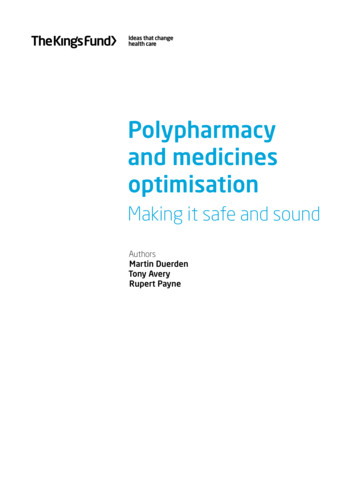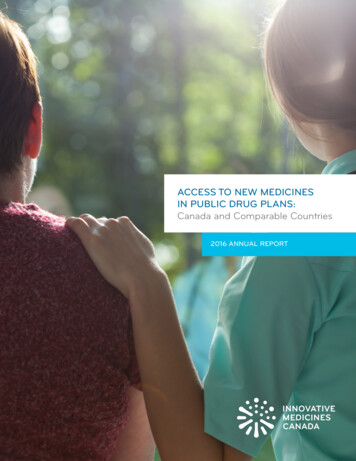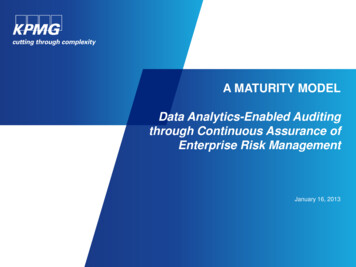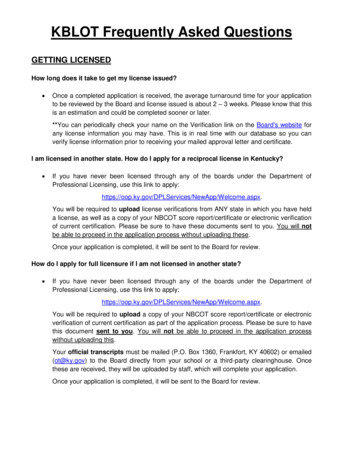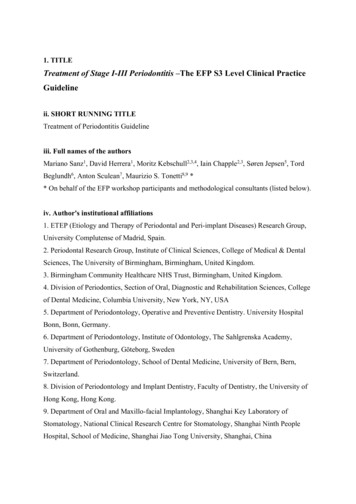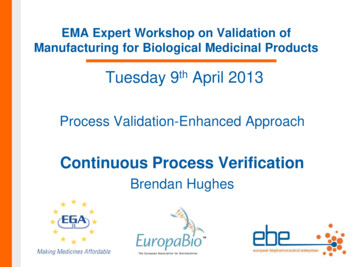
Transcription
EMA Expert Workshop on Validation ofManufacturing for Biological Medicinal ProductsTuesday 9th April 2013Process Validation-Enhanced ApproachContinuous Process VerificationBrendan Hughes
Agenda Definition and purpose of validationThe process knowledge lifecycleProcess knowledge during PDSources of process knowledgeUse of small scale modelsEvolution of a control strategyConfirmation at scaleContinued process verificationLifecycle management using Continued processverification2
Process validation establishing by objective evidence that aprocess consistently produces a result or productmeeting its predetermined specificationsEvolving landscape with greater focus on aLifecycle ApproachPV approach likely to be a continuum from‘traditional’ to ‘enhanced’-‘Enhanced’ PD do not always provide for ‘Enhanced’PV and ‘Enhanced’ PV incorporating Continuousprocess verification can be conducted with varyingamounts of process understanding; a controlstrategy is the enabler3
Pre-requisites for Process ValidationProduct knowledge Criticality assessment Structure function studies Prior knowledgeProcess knowledge Univariate and multivariateanalyses Prior knowledge (platform) Scale down and model studiesControl Strategy Parametric and attributecontrol On-line/at-line/off-line Settings to detect incontrol/out-of controland trending Actively managed as part ofproduction ,batch disposition andcontinuous improvement4
Development of product and processknowledgeCQALab-based examination (bioassay, binding)Pre-clinical studiesClinical studies and outcomesLab-based process developmentCPPPilot scale batches for tox supplyClinical manufactureScale-up batches5
Role of scaled-down modelsCost: lower fixed assets needed for experimentationTime: Faster turnaround between runs. More data.Data density: Higher ‘n’ of runs using multiple identicalequipment setsFlexibility: Easy to improvise and experiment Complex interaction studies Replication for statistical validity Data rich-process knowledgeChallenge: Extrapolation of rich database of knowledge to fullscale (see presentation Frank Zettl)6
Development of a control strategy Fundamentally exists to describe and managethe influence of CPP on CQA Comprehensive with quantitative criteria- Raw material controls- Control of intermediates- Process parameter control- Multi-step, multi factor CPP for single and multipleattributes- Yields attribute control within acceptable ranges formanufacturing7
Control Strategy-across a biotech processBiosynthesisMake rightproductRaw materialsProcess controls inBioreactor to managecell growth and productqualityIn process measurementsPurificationDegradationSelect andprotectPreserveRaw materialsChromatographyand filtration controlMicrobiological controlParametric controlFormulationStorage8
Control strategy examplesBIOREACTORDOWNSTREAMHCP Culture duration Culture conditions (VCD as output) Column operating parameters Column lifetime (IPC for HCP as output)Glycan Culture conditions Raw material Chromatography selectivity Bioburden control (Control Temp/Conductivity) Culture conditions Chromatography selectivity Control of generation In process testingHMWFormulationand Fill Formulation processFilling processStorageFinal product testing9
Confirmation at scale Limited numberruns At-scale data for allUnit Ops Key stage inconfirmation of PV Multiple runs Information density Interaction data Extensive evidence ofprocess performance Examination of performance atmultiple parameter set pointsForms the basis for ContinuousProcess VerificationLimited number of runsat full-scale Focus on confirmation ofcontrol strategy at scale Limited ranges explored Selection of set-pointsand testing to maximisevalue of at-scale-data Cannot directly testedges of Design Space atscale10
Continuous and Continued ProcessVerificationContinuous Continuous Process Verification:An alternative approach toprocess validation in whichmanufacturing processperformance is continuouslymonitored and evaluated.Demonstration that the process isvalidated (under specified control)Based on control strategy andprocess knowledgeApplied at various scales andstagesComposite of data from lab andvarious scale manufacturingCan include multiple data sources(IPC, batch, in-line at line off-line)Continued Demonstrating themaintenance of the validatedstatePart of ongoing manufacturingand lifecycle managementCan include some or all of thedata sources used todemonstrate ContinuousProcess Verification
Continued (ous) process verificationDesign based on process knowledge Testing and monitoring designed to assesscontrol and maintenance of validated stateIntegrated Measurement Analysis Activelymanaged In-line/At-line/Off-line Attribute and Parameter Established control, alert, reject limitsStatistical analysis Link to plant and lab automation systemsContinuous monitoring and review Continuous improvement12
Continued (ous) process verification:what to measure? Critical Parameters and Critical Attributes- Based on Process and Product DevelopmentWhat role for measurement of attributes shown to be non-critical forefficacy?- Markers of process consistency- Only if non-redundant or indicator status- Knowledge develops over time and batch manufactureexperienceMaterial and intermediate attributes linked to CQA outcomesIndirect or indicator parameter or attributes demonstrating drift orloss of control- Multi-signal/multi-parameter probes- Shear forces, gas exchange rates, column-ligand density, noncritical attribute abundance or quality13
Continued (ous) process verification:data treatment Univariate and importantly multivariate analysis to evaluateinteractionsTrending and analysis- Alert and action limits- Maintenance of product qualityContinuous improvement- Setting of limitsIn-specificationIn-trendMoving process performance to optimalProcess change and improvement-Using Continuous process verification to demonstratemaintenance of control following process change14
Example: Infrastructure for effective process monitoring/Continued and Continuous Process VerificationSIMCA 13 – Off-lineDataanalysisandprocessing Multivariateanalysis. Describethe ‘golden batch’with process data. Watch and bealerted for batchesdeviating from‘golden batch’. React. Charting data using SPC tools. Apply analytical rules e.g., Western Electricrules to interpret charts. Use totality of process knowledge to ‘correct’process if alertedDataaggregationfrom varioussources e.g.,LIMS, MESetc.15
Lifecycle management:Role of process verification Process Maintenance and Improvement- Demonstration of control after process change- Response to drift or variabilityEquipmentScaleRaw materialBased on well-designed Continued ProcessVerification program-Confidence of control by analysis of key indicators ofprocess control and validation16
Filing requirements Continuous Process Verification: datasupporting this will be in the filingContinued Process Verification is aprospective proposalThe design basis for the Continued ProcessVerification program may be described in thefiling but the data are in the GMP systemLocation of these descriptions in the filings?Important linkage between review andinspectorate17
THANK YOU18
Continuous and Continued Process Verification Demonstrating the maintenance of the validated state Part of ongoing manufacturing and lifecycle management Can include some or all of the data sources used to demonstrate Continuous Process Verification Continuous Continued Continuous Process Verification: An alternative approach to
